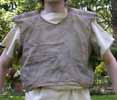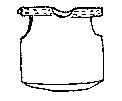LEGIO XX ONLINE HANDBOOK
SUBARMALIS 8/8/04
----------
*Home*Handbook Intro*Tunic*Caligae*Cloak*Belt*Helmets*Segmentata*Hamata*Squamata*Subarmalis*Scutum*Gladius*
*Pilum*Pugio*Packs*Mess
Gear*Tools*Crests*Drill*Leatherworking*Armoring*
----------

|
We use the term subarmalis
to refer to the garment worn under the armor to protect clothing and body
from chafing and soiling. There are several literary references to
it, though at least one is ambiguous and may refer to a weapon. A
4th century description, which uses the term thoracomachus, says it is
made of thick cloth, covered with leather (or with a separate leather garment
over it) for waterproofing. However, there are no confirmed archeological remains
or certain depictions. |

|
One important function of the subarmalis
is to give the shoulders padding against the weight and abuse of the armor.
M.C. Bishop points out that shoulder pads also raise the collar plates
of a
lorica segmentata up to the narrower part
of the neck, alleviating "neck pinch", and causes the breast plates to
hang straight, not at an angle. (Original breast plates always
have their straps and hooks mounted vertically and horizontally, but do
not show evidence of the angled stress suffered by modern reconstructions.)
The exact form of your
subarmalis
is up to you. Padding for the shoulders can be as simple as a 12"
to 18" square of sheepskin with a headhole cut in the center, but a
more
complete garment is recommended. It should fit fairly closely and
be more or less hidden by your armor, though it should cover the parts
of your tunic which would otherwise be in contact with your
armor. It may be a pullover like a
tunic, or have an opening at the front or side. It may be any
combination of linen,
wool, or leather, and can be padded at the shoulders or all
over.
A side or front opening can overlap to allow adjustment, and can
simply be closed with cloth or leather ties (though buckles cannot be
ruled out!). An opening also allows the subarmalis to fit closer
to the body, keeping it from being unnecessarily bulky. A
pullover style, on the other hand, is very quick to put on.

|
At left is
a back view of the subarmalis shown above. The outer layer is
oznaburg linen, and the shoulders are padded with wool scraps.
The arm openings are cut back slightly so as not to stick out beyond
the armor. Note the little flaps under the arms--these hang out
over the tops of the lorica segmentata girdle plates, protecting the tunic sleeve from the metal, and the metal from wetness and rust.
The padding in the body shown at
right is not really necessary with a lorica segmentata, but is vital
with lorica hamata.
|

|
A subarmalis with a linen lining
and an outer layer of wool, heavy linen, or leather can be made as follows.
Start with a short linen "tunic", a little longer than your armor and just
wide enough to get into, sleeveless, with a narrow neckhole. (Since
it is a lining it is made "inside out"--with finished side towards your
body.) Pin folded scraps of fabric (or pieces of fleece) to the shoulders
and adjust them to the desired placement and thickness, trying on your
armor for a good fit. (If you have no armor yet, the length should
be a few inches below your waist for a lorica segmentata, or about knee-length
for a hamata. The shoulder padding should be c. 1/2" thick.)
Stitch the padding in place. Make the outer covering a little wider
and a couple inches longer than the lining. Put the layers together
and secure at the neckhole by turning in the edges and stitching.
Quilting the padding in place is also a good idea.
A subarmalis made to be worn under
a plate iron lorica segmentata only really needs padding in the shoulders.
Padding in the body area is not necessary, and may end up becoming too
bulky under the armor. For wearing under mail or scale, however,
padding in the body is much more desirable. This can be anything
from sheepskin to a couple layers of blanket wool (from thrift stores),
or a layer or two of leather.
Now put on your subarmalis and
your armor, and make sure that the subarmalis is not bunched up or crooked.
Trace around the bottom edge of the lorica, cut off any excess fabric and
hem. Also mark and trim at the armholes so that there is only enough
subarmalis projecting beyond the metal to protect the tunic, and hem that,
too. It is a good idea to attach a narrow fabric flap along the bottom
of each armhole, to hang out over the edge of the armor and protect the
tunic from it.
The color of the subarmalis is
not important and is (within reason!) up to you. It is possible that a soldier would
make his own subarmalis using old tunics.
Records show that some soldiers were going through 8 to 10 tunics per year,
so perhaps one that was too ragged or stained to wear would be cut up for
a new subarmalis, or socks, or helmet padding,
or cleaning rags.
A good subarmalis is shown here, http://florentius.com/subarmalis.htm, and another one in the Equipment section of the Legio VI Victrix site, http://www.legionsix.org/.
Pteruges (rows of flaps) may be attached at the shoulders and hem if you
wear mail or scale
armor, but they seem not to have been worn with the lorica
segmentata
very often. (This
is a Hellenistic fashion held over from the Greek linothoraxor
linen cuirass of the 5th century BC.) The finished and hemmed
edges of the subarmalis, in this case, should end just short
of the edges of the mail at the hem and arm holes, and the pteruges are
attached to hang out beyond the mail, in two staggered
rows with the inner row slightly longer than the outer one.
The individual flaps are around 2 to 2-1/2 inches wide,
and the length is slightly less than the tunic hem or sleeves.
Like
the rest of the subarmalis, we do not know what pteruges were made of,
so they may be leather or layered fabric. Those worn by common
soldiers were perhaps more likely to have been thicker and more
functional, whereas some of those seen on sculptures of aristocrats
seem to be rather floppy, more of a traditional feature than
defensive. There is commonly a line around the edge of each flap,
which may be a tooled line, stitching, or even a sewn-on border.
Centurions and higher
officers often have pteruges with short thick fringe at the ends,
possibly made of wool yarn or metallic thread. (Please do NOT use
modern synthetic fringe!) Other than that, pteruges have no other
decoration such as studs or appliques! On lower-ranking soldiers,
the pteruges
might have rounded ends, but most (and any fringed ones) are simply
square and straight. They do not seem to be flaired or tapered at
all--the edges should be parallel. There are also no gaps between
the flaps where they meet at the top, so if you make each flap
separately they should lie edge-to-edge. If your pteruges
are a single thickness of leather, you can cut out a rectangle whose
length is equal to the circumference of your subarmalis hem (or
armhole), and slit it to form a large fringe of flaps, as it were,
joined at the top. This is then sewn to the body of the
subarmalis, or tied on with thongs if you want it to be removable for
washing the fabric part. (Also see Leatheworking Tips.)
The Louvre Relief, http://www.livius.org/a/1/romanempire/praet_guard.jpg,
shows pteruges on several men. One appears to be wearing them
OVER his cuirass, but this might be showing a short muscled cuirass
worn over pteruges which "puff" out due to their own bulk. Or, in
this case, the pteruges might actually be attached directly to the
armor.
Pteruges might
have been white, brown, red, yellow, or even blue or some other color
(maybe even with a contrasting color border). There is very
little evidence from which to work.
----------
*Home*Handbook Intro*Tunic*Caligae*Cloak*Belt*Helmets*Segmentata*Hamata*Squamata*Subarmalis*Scutum*Gladius*
*Pilum*Pugio*Packs*Mess
Gear*Tools*Crests*Drill*Leatherworking*Armoring*
----------
*Home*Schedule*Handbook
*Auxiliaries *Civilian
Clothing *Cold-Weather Clothing *Signum*LINKS*SUPPLIERS*Bibliography
*
*ADLOCVTIO*Tent
and Camp *Roman Days*History*Names
*Advice
on Starting a Group *PHOTOGRAPHS*Bylaws
*Membership*



